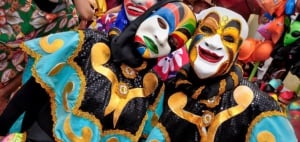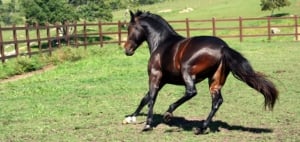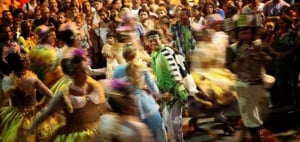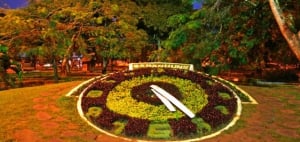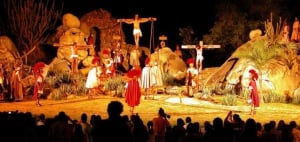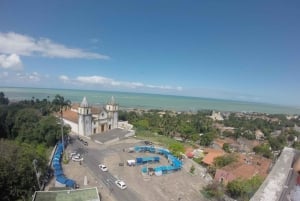The Agreste (Hinterland)
The Agreste is the third latitudinal region of Pernambuco State. With a hillier landscape, drier weather, cooler temperature and smaller towns, Pernambuco's hinterlands are a charming destination which attract more and more visitors, from Brazil and abroad.
Caruaru (132km from Recife) is considered "the capital of the Agreste", for being its largest and most economically important city. It is best known for its exciting São João and traditional handicraft.
This is where the country's biggest São João party happens. The celebration takes place between May and June and stretches for over 30 days, receiving up to 1 million people. During the month-long party, the typical rhythm of forró is played everywhere in all its varieties, from the most traditional, acoustic form to its modern, eletronic spinoffs (more popular with the pop generation). The biggest attractions take place in the Pátio de Eventos, also known as Pátio do Forró, though the festivity is pretty much well spread across town. Make sure you see the "quadrilha" dance presentations: colourful displays of joy and tradition dating back to European dances.
While São João only takes place once a year, handicraft is an attraction that goes on through all seasons. The "Feira de Caruaru" is a 200 year old fair with a staggering amount of items: handicraft, regional food, clothing articles, medicinal herbs, electronic devices and an array of goods on leather, fibres, wood and more. Make sure you check prices before buying - differences between sellers can be significant. Another popular fair is the "Feira da Sulanca" on Mondays, where clothing articles are for sale for well below market prices
The "Alto do Moura" (7km from downtown Caruaru) was declared the largest figurative art centre in the Americas by Unesco, so it is a mandatory stop if you want to find the best samples of Pernambuco's art and handicraft. You can visit the studios of renowned local artists, including the Casa-Museu Mestre Vitalino, the unpretentious dwelling of Mestre Vitalino, the artisan whose clay sculptures became synonymous with Pernambuco's art. The house is now a museum and shop run by one of his sons. Other enriching stops are the Museu do Barro - Espaço Zé do Caboclo and the Museu do Forró - Luiz Gonzaga. The museums are neighbours to one another, in the "Espaço Cultural Tancredo Neves", and each tell something of the culture of Pernambuco and Caruaru. The former is dedicated to clay handicraft and has one of the largest national collections of clay art. The latter is dedicated to Luiz Gonzaga, the legendary musician who single-handedly revolutionized Brazilian music with his accordion.
Bezerros (100km from Recife) is best known for its Carnival. Though it is the third most popular one in the State, Carnival in Bezerros remains a fun and welcoming party for the whole family, as its scale is not as overwhelming as in Recife or Olinda. Its traditional figures are the "Papangus", fully disguised dancers who bring colour and fun to the town's streets. Their characteristic papier maché masks are a trademark of the city's handicraft and can be purchased in fairs and ateliers.
If you're not here in February, there is still much more to do. The city is well known for its artcraft, as it is home to the most famous xylographer in the State: J. Borges. You can visit his and other artisan's studios, as well as the centres "Centro de Artesanato de Pernambuco" and "Casa da Cultura Serra Negra" for finding high quality handicraft. Besides xylography, the colourful papier maché masks are also a joyful souvenir.
Lastly, Bezerros is also popular for people interested in adventure sports and being in contact with nature. In the Reserva Ecológica Serra Negra, visitors can see spring water fonts, caves, rocky formations and preserved Atlantic Forest, besides trekking, horse riding and rappelling.
By looking at the steep roofs on the houses, whose architecture mimmicks European chalets, you might think they are expecting heavy snow in this town. But in Gravatá (85km from Recife), though it gets cold, that is never the case. With an average annual temperature of a pleasant 21°C, Gravatá is a popular destination for people from the capital, who enjoy spending their winter and weekends in this city's bungalows, cottages and hotels, basking in its mild climate and gastronomic excellence.
There are many options among local restaurants, though the local specialities are beef, cheese and fondues (not to mention the best "coxinha" in the region!). Every year the city hosts a gastronomic festival, displaying its fine cuisine. And if you'd like something sophisticated to go along with your fancy meal, stay in town for the "Virtuosi", a free classic music festival which happens here and in other main cities of Pernambuco, featuring world-class musicians.
Gravatá also holds something special for visitors on Christmas. Every year on Holidays, the town hosts several spectacles combining theatre, lights and music to create a world-class show. Think Cirque du Soleil on nativity scenes.
Among local hotels, many have specialized in rural tourism, offering leisure options such as horse riding, fishing, trekking in caves and waterfalls. Gravatá has even become an important centre for the equine business, holding congresses and auctions such as the yearly "Festa do Cavalo".
Do not, however, let this slow-paced, idyllic prelude mislead you: Gravatá has much excitement to offer! In September, the "Festa da Estação" brings big concerts to heat things up in town. If you visit the city during São João or Easter, you are likely to find good attractions also.
Gravatá is also well known for its handicraft, particularly woodwork and furniture. In the Duarte Coelho street, you'll find over 70 stores specialised in furniture (both contemporary and rustic). The "Estação do Artesão", a train station converted into handicraft centre, also displays an interesting variety of items.
Standing over 800 meters above sea level on a hilly landscape, Garanhuns (230km from Recife) is also favourite among locals and other visitors from Brazil, due to its cool temperatures, it's known as "The Brazilian Switzerland", and charming atmosphere. Take a stroll along its squares, abundantly adorned with flowers, and you'll see what we mean. One of its famous tourist sites is a flower clock " O Relógio das Flores", worth taking some shots.
Temperatures can drop quite low, down to 12°C, which makes Garanhuns, along with Triunfo, one of the coldest towns in the Northeast. Of course, if you're a visitor from those portions of the planet where single-digit temperatures are the norm, you might find this town's weather rather mild. For locals, nonetheless, the slightest temperature drop is good enough an excuse to take that heavy fur coat out of the closet.
It is best known for the "Festival de Inverno de Garanhuns", or FIG, a 10-day winter festival which takes place in July. The FIG is famous across the country and has an ever-growing list of free attractions: concerts, literature, fashion, theatre, circus and more. As many as 300 shows take place, with music genres go from classic to popular, besides hundreds of other cultural attractions spread across town.
Also, if you feel like escaping the crowd and noise of Carnival, in February Garanhuns also hosts the "Garanhuns Jazz Festival", which brings free concerts, master classes and other attractions, including international performers. But of course, since this is Brazil and not Montreux, later on in the party you're liable to hear pretty much every rhythm the crowd asks for.
This region's main attraction is the "Paixão de Cristo" , an open-air theatrical show it hosts every Easter. The 100.000 m² theatre-town called "Nova Jerusalém" (New Jerusalem) is where this spectacle has been taking place for decades. The city replicates some of the sites where Jesus spent his last moments on Earth, and the crowd of thousands of spectators is invited to walk from setting to setting, eventually becoming part of the play.
Over the years, it has grown into a massive attraction and it is now carried out by the country's leading television and entertainment group (Rede Globo). In other words, you'll see some of Brazil's best known actors and actresses, plus blockbuster-like special effects. Packages for the spectacle are sold by travel agencies in the preceding months.
Between the Agreste and the Sertão, the Serra do Catimbau stretches over an area of 62 thousand ha, characterized by rocky hills, made smooth by erosion, and exuberant display of the Caatinga, a biome endemic to the Northeast of Brazil.
A national preservation park was created in this area and is open to ecotourism. One of the most striking features are the cave paintings found on site, some dating as far as six thousand years past. The only national park to surpass Serra do Catimbau in archeological importance is the Serra da Capivara, in the neighbour State of Piauí.
The breathtaking scenery, with tall hills and cliffs shooting out of the grayish green vegetation, has made the Serra do Catimbau a favourite destination for trekking, cycling and other varieties of ecotourism.
* Photos by Beto Figueiroa, Paloma Amorim (EMPETUR), Evaldo Parreira and João Tavares (EMPETUR).


